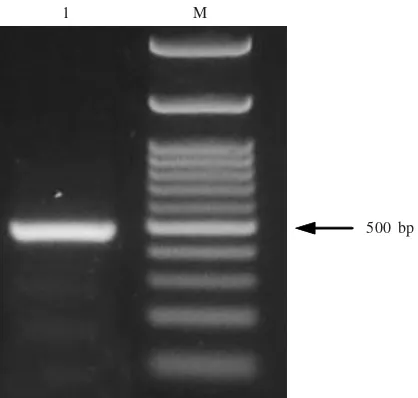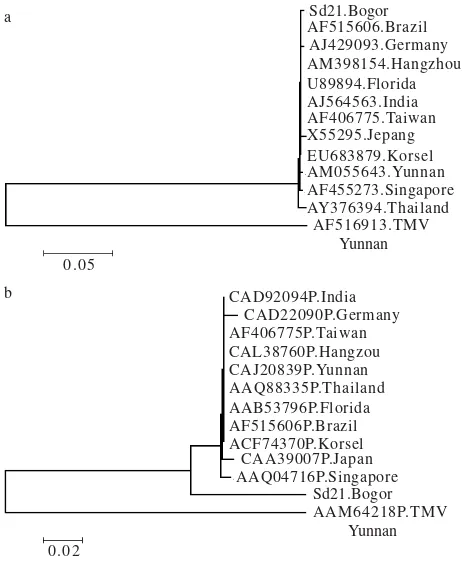HAYATI Journal of Biosciences June 2010 Vol. 17 No. 2, p 101-104
EISSN: 2086-4094
SHORT COMMUNICATION
Identification and Molecular Characterization of
Odontoglosum Ringspot Virus
(ORSV) from Bogor, Indonesia
IRWAN LAKANI1, GEDE SUASTIKA2, NURHAJATI MATTJIK3, TRI ASMIRA DAMAYANTI2∗∗∗∗∗
1Faculty of Agriculture, Tadulako University, Kampus Bumi Tadulako Tondo, Palu 94118, Indonesia
2Department of Plants Protection, Faculty of Agriculture, Bogor Agricultural University,
Darmaga Campus, Bogor 16680, Indonesia
3Department of Agriculture and Horticulture, Faculty of Agriculture, Bogor Agricultural University,
Darmaga Campus, Bogor 16680, Indonesia
Received January 5, 2010/Accepted June 4, 2010
Recently, field surveys were conducted in several orchid nurseries in Bogor (West Java), Magelang (Central Java) and Malang (East Java). We found that most of the commercially orchids sampled from Bogor was infected by virus-like disease. The symptoms depend on the orchid species. Thus, the symptoms varied such as mottle, mosaic and necrotic flecks either on the leaves or on the flowers. Similiar symptoms were not found in samples obtained from Central Java and East Java. A Tobamo-like virus was inferred to be possible cause of the viral disease-like symptoms. Serological test of the samples by ELISA showed positive against Odontoglosum Ringspot
Virus (ORSV) antibody and was negative against Cymbidium Mosaic Virus (CyMV) antibody. Total RNA was
extracted from symptomatic plants and RT-PCR was carried out by using a pair of coat protein (CP) gene primer of ORSV. It was successfully amplified a 500 bp of DNA fragment and it was directly sequenced. The nucleotide sequence of CP gene had confirmed the identity of ORSV. Phylogenetic analysis based on the CP nucleotide sequences were grouped into only one major cluster. The ORSV isolate from Bogor (Sd 21) and the other isolates were clustered in the same group and had highest nucleotide homology (99%). These results provide first evidence of ORSV infecting orchids in Bogor, Indonesia.
Key words: Odontoglosum Ringspot Virus, orchid, Tobamovirus
___________________________________________________________________________
Available online at: http://journal.ipb.ac.id/index.php/hayati DOI: 10.4308/hjb.17.2.101
_________________ ∗
∗∗
∗∗Corresponding author. Phone/Fax: +62-451-429778, E-mail: lakani15@yahoo.com
INTRODUCTION
Orchids can be infected by approximately 50 viruses (Zettler et al. 1990; Chang et al. 2005; Navalienskiene et al. 2005). The most important type of virus infecting orchids in the world is Odontoglosum ringspot virus
(ORSV) (Zettler et al. 1990; Sherpa et al. 2004). It is also reported that the virus infects vanilla plant (Grisoni et al. 2004), and is considered as the most prevalent and economically important virus infecting orchids in Florida as well as worldwide (Jensen & Gold 1951; Zettler et al. 1990). The ORSV infecting orchid showed various symptoms such Odontoglosum grande ringspot on leaves, also stripe breaking (mottle), diamond-shaped, mosaic, color burst on Cymbidium flowers and also color breaking on Cattleya. The symptoms were depend on orchid spesies. The ORSV infects approximately 31 orchid genera (Jensen & Gold 1951; Zaitlin 1976).
Recent field study conducted between 2007-2008 at several orchid nurseries in the Java island, we found that most of the orchids were infected by virus-like disease. The infected leaves and flowers showed various
symptoms which were appeared as concentric mosaic, necrotic on the lower part of leaf, leaf malformation, necrotic and some were symptomless (Figure 1), especially those samples from Gunung Sindur-Bogor.
The aim of this research was to identify the cause of those symptoms on orchids from Bogor. Basic information obtained from this study will contribute to find out appropriate management strategies of the disease.
MATERIALS AND METHODS
Source of Inoculum. Thirty symptomatic Dendrobium
orchids were collected from the orchid seedlings in Gunung Sindur-Bogor. Samples were subjected to serological test, viral purification, and molecular detection by Reverse Transcription-Polymerase Chain Reaction (RT-PCR).
Serological Test. Samples were tested with Enzyme-linked-immunoabsorbent assay (ELISA) by using antibodies against ORSV and Cymbidium Mosaic Virus
Virus Isolation and Propagation. To isolate ORSV and separate it from other viruses which may present in the same sample, symptomatic leaves were infected to local lesions of Datura stramonium as the host. Leaves were homogenized in 0.05 M phosphate buffer pH 7.5, the sap was inoculated to D. stramonium mechanically (Sambrook
et al. 1989). Leaves were dusted with carborundum
600 mesh prior to the mechanical inoculation. The inoculated plants were maintained in an insect-proof house for symptomatic development. After 3-21 days post inoculation, D. stramonium showed local lesions. Part of the local lesion was used as inoculum to inoculate D.
stramonium serially. Similar procedure was repeated three
times to obtain a pure virus source. Finally, the virus was propagated on Nicotiana tabacum by mechanical inoculation using the local lesion from last passage and the inoculum were used for further test.
Molecular Detection. Total RNA was extracted from a 0.1 g symptomatic leaves of Nicotiana tabacum using Total RNA extraction kit (Rneasy Plant Mini Kit, Qiagen, USA). Total RNA was used as a template for complementary DNA (cDNA) construction by using reverse transcriptase enzyme M-MULV (NEB) according to manufacture protocol. RT-PCR was carried out by using a specific primer for ORSV CP gene (forward primer ORSV-cpF 5-’GCTCTAGAATGTCTTACACTATTACAGACC-3') and reverse primer ORSV-cpR (5'-GCTCTAGAATGGGT CGTTTRGCGTTTTGTAG-3') (Ajjikuttira et al. 2005). PCR conditions for DNA amplification were 35 cycles at 95 oC
for 30 sec, 50 oC for 45 sec, 72 oC for 1 min, and final
extension at 72 oC for 10 min. The 500 bp DNA product
was analyzed on 1.2% agarose gel containing 0.5% ethidium bromide under UV illuminator.
DNA Sequencing and Phylogenetic Analysis. RT-PCR product was subjected to nucleotide sequencing at PT Charoen-Phokphand, Jakarta, Indonesia. The CP sequence was aligned with ClustalW software of BioEdit program Version 7.0.0 (Isis Pharmaceuticals, Inc). The phylogenetic tree was constructed by using MEGA version 4.0 software (Tamura et al. 2007), with neighbour-joining method and
maximum composite likelihood model to estimate the distance and bootstrap support was estimated with 1000 replicates.
RESULTS
Serological Test. Samples from Gunung Sindur showed a positive reaction against ORSV antisera and some of them also positive against CyMV. Typical symptomatic plants with positive reaction against antisera ORSV used as a source of inoculum. The infected orchid plants showed variation of symptoms such as mosaic, concentric, necrotic spots on the lower part of the leaf and leaf malformation, and the flowers found in the necrotic symptoms (Figure 1).
Molecular Detection and Phylogenetic Analysis. RT-PCR confirmed the existence of ORSV, a 500 bp DNA was succesfully amplified (Figure 2). Phylogenetic analysis of the DNA compared with those other ORSV showed
Figure 1. Symptom Variation of orchids infected by ORSV: (a) mosaic; (b) concentric mosaic; (c) necrotic under leaf; (d) leaf malformation; (e) necrotic on flower; and (f) symptomless.
a b c
a b c
500 bp 1 M
Figure 2. RT-PCR detection of ORSV with specific primer of CP gene. Lane 1: ORSV Bogor; lane M: represents molecular weight marker 100 bp (NEB).
highest homology corresponding CP gene of 55 ORSV in Genbank (98-99%). Bogor isolate (Sd 21) was closely related to the other isolates from other countries (Data not showed). Amino acid sequences, however had homology only 80.7-81.3% with the other isolates. Whereas, in comparison with Tobacco mosaic virus isolate from Yunnan, the homology of CP nucleotide and amino acid only 66 and 64%, respectively (Table 1). This indicates that ORSV has distantly related to TMV.
Phylogenetic tree analysis of nucleotide indicated that Bogor isolate is very closely related to the other isolates and showed only one major group. TMV is considered as
out of group. ORSV of Bogor isolate was closely related to the isolates from Thailand, Brazil, Hangzhou, Taiwan, India, South Korea, Florida-USA, Yunan, Japan, Singapore, and Germany (Figure 3). However, there were three nucleotide insertion and mutation present in the CP gene of ORSV isolate from Bogor compared with the other isolates. Base insertions were at nucleotide position number 151, 189, and 230. Meanwhile, point mutation occurred from C to T at nucleotide number 4 from the 5’ terminal of CP gene. These base insertion and point mutation might affect the amino acid composition. The amino acids changed from amino acids number 51 up to 76, while two insertion of amino acids were present at position between number 55 and 56. Further, there was three additional deletion of amino acid at position number 76, 77, and 78 (data not shown).
DISCUSSION
Until present study, ORSV is considered as an exotic virus. This study provides evidence of ORSV Bogor, Indonesia. Generally, orchid is propagated vegetatively, and is commercially traded worldwide. In Indonesia, most of orchids is imported from other countries. Thus, the presence of ORSV infecting the orchids might occur accidentally through vegetative materials from abroad. Member of Tobamovirus has stable viral particles, easily transmitted mechanically and some of them are seed transmitted, including through vegetative materials. Serological test of samples showed that ORSV could infect orchids on its own or together with CyMV. It might cause various symptom on orchids such as mosaic and necrotic spots on the leaf when single infection of ORSV occur and upward-rolling and stunting leaf when occur dual infection of ORSV and CyMV.
Based on part of CP nucleotide, it showed that ORSV from Bogor isolate had closely related with the other ORSV from several Asian countries, Europe and America. It is suggesting that ORSV from Bogor isolate might be originally from one of those countries via vegetative materials. Phylogenetic analysis of the CP nucleotide confirmed the genetic relationship of ORSV from Bogor isolate with those corresponding isolates. However, the homology of amino acid sequence was less than 90% (80.7-81.3%) compared with the other isolates. It might be caused by base insertion, point mutation and deletion which occurred in the CP gene. Base alteration shifts the amino acid codon. Alternatively, there are changes in amino acid compositions and lead to lower similarity of amino acid sequence compared with the other isolates. These might occur due to natural adaptation of virus to Indonesia environment.
REFFERENCES
Ajjikuttira P, Loh CS, Wong SM. 2005. Reciprocal function of movement proteins and complementation of long-distance movement of Cymbidium mosaic virus RNA by Odontoglossum ringspot virus coat protein. J Gen Virol 86:1543-1553. Tabel 1. Partial identity betwen CP gene of ORSV isolate Bogor
compared with other Tobamovirus member
Coat Protein Sequence identity were calculated with BioEdit version 7.0, Isis Pharmaceuticals, Inc. Nt: nucleotide; aa: amino acid.
Figure 3. Phylogenetic analysis of CP nucleotide of ORSV (a) and amino acid (b) isolate from Dendrobium orchid Bogor. The tree were inferred by neighbor-joining method using MEGA software version 4.0. The tree was rooted using TMV as out group. The bar at the bottom left represents 0.05 and 0.02 nucleotide change per site.
104 LAKANI ET AL. HAYATI J Biosci Chang C, Chen CY, Hsu YH, Wu JT, Hu CC, Chang WC, Lin NS.
2005. Transgenic resistance to Cymbidium mosaic virus in
Dendrobium expressing the viral capsid protein gene.
Transgenic Res 14:41-46.
Grisoni M, Davidson F, Hyrondelle C, Farreyrol K, Caruana ML, Pearson M. 2004. Nature, incidence, and symptomatology of viruses infecting Vanilla tahitensis in French Polynesia. Plant Dis 88:199-124.
Jensen DD, Gold HA. 1951. A virus ringspot of Odontoglosum
Orchid: Symptoms, transmission and electron microscopy.
Phytopathol 41:648-653.
Navalinskiene M, Raugalas J, Samuitiene M. 2005. Viral diseases of flower plants. Identification of viruses affecting orchids (Cymbidium Sw.). Biologija 2:29-34.
Sambrook J, Fritsch EF, Maniatis T. 1989. Molecular Cloning A Laboratory Manual. 2nd Edition. New York: Cold Spring Harbor
Lab Pr.
Sherpa AR, Hallan V, Zaidi AA. 2004. Cloning and sequencing of coat protein gene of an Indian Odontoglossum ringspot virus
isolate. Acta Virol 48:267-269.
Tamura K, Dudley J, Nei M, Kumar S. 2007. MEGA 4: Molecular evolutionary genetics analysisi (MEGA), version 4.0. Mol
Biol Evol 24:1596-1599.
Zaitlin M. 1976. Letter to the Editor. Viral cross protection: more understanding is need. Phytopathol 66:382-383. Zettler FW, Ko NJ, Wisler GC, Elliot Mark S, Wong SM. 1990.

